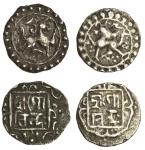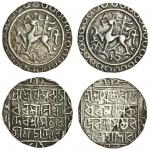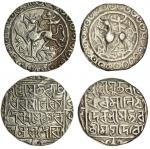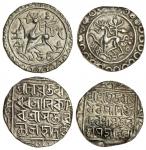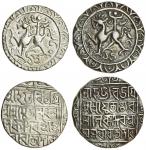The Nicholas Rhodes Collection: Coins of North East India (Part 2)。Tripura (late 16th century), counter-stamped Tankas (2), head of lion of Tripura on Chittagong, trade Tankas of governor Vamar Shah, AH988 (N. Rhodes, Some Coins Countermarked in Tripura, JONS #203, Spring 2010, pp.14-16; host coins G & G. B.1017; Michiner, Land of Water 306), host coins about very fine, countermarks containing dark deposit but a little better, host coins rare, with this countermark they must be considered extremely rare (2). Subject to 20% VAT on Buyer?s Premium. For more information please view Terms and Conditions for Buyers.。These coins are illustrated in the Rhodes JONS article (#3 & 4). The lion-head countermark is similar to the head of the lion on coins of Amara Manikya and Rajadhara Manikya of Tripura. The trade coins that host them name a Sultan Vamar who may have been an Arakanese governor of Chittagong or a local potentate whose identity is uncertain. Their date, read as AH988, suggests they were issued after 1580. As almost identical countermarks are also found on coins of the Dimasa-Kachari kingdom issued in the late 16th century (see lots 218 & 220), Rhodes suggests that both types were countermarked in the 1590s. After considering whether the marks were merely shroff marks made by local bankers, or applied in Tripura by the authorities to validate their circulation there, Rhodes decided that it is more reasonable to think they were applied by the Tripuran authorities to validate the coins for export from Tripura. He came to this conclusion as it is likely that the striking of coinage in Tripura was used as a method of raising revenue by the rulers. Any silver bullion coins brought in to the country would have to be re-struck at the mint, and could only then be exported as legitimate Tripura issues. This lion-head countermark could be one way of making them legitimate. No coins with this countermark are found in Tripura itself which makes it unlikely they were destined to circulate locally, and he was not aware of other Chittagong trade coins of this period bearing different shroff marks, which would have been the case if countermarking was common amongst the traders.













